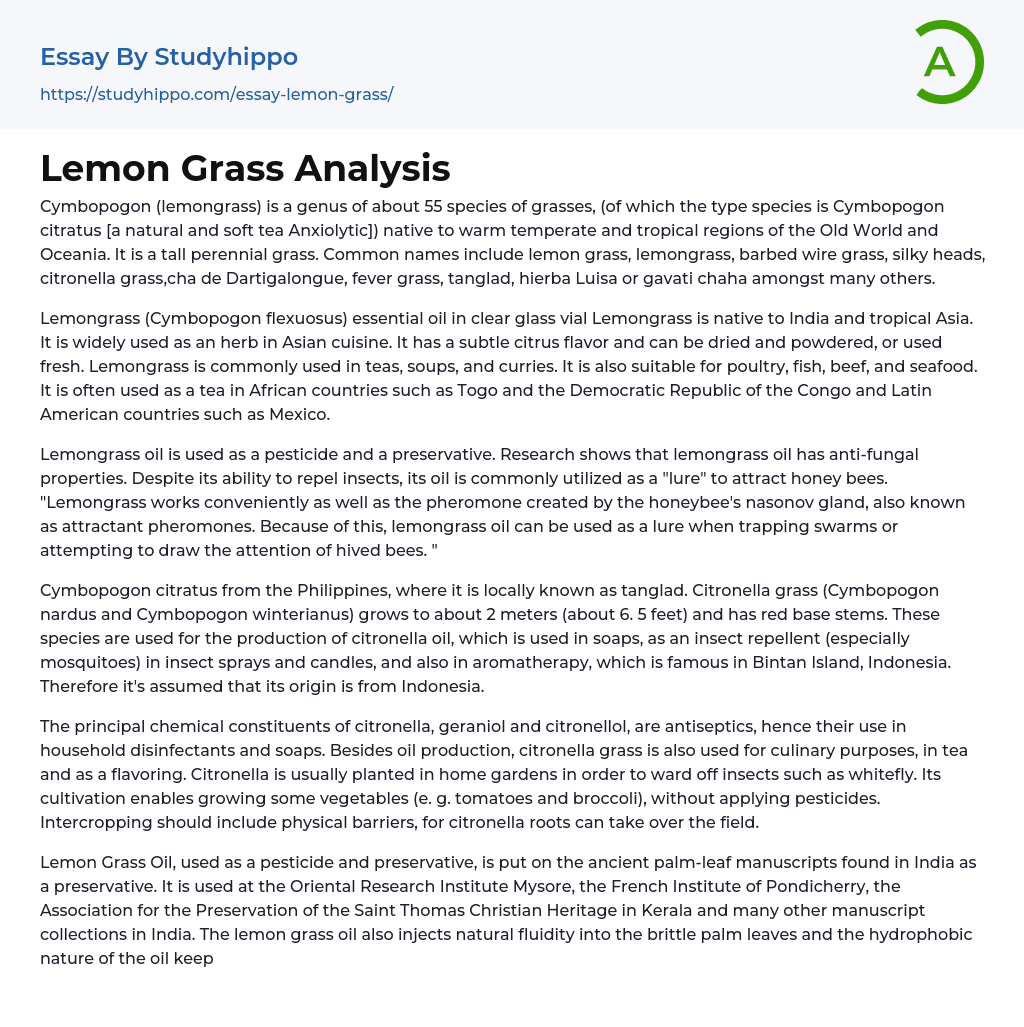Cymbopogon, which is also called lemongrass, belongs to a genus of around 55 species of tall perennial grass. The primary species, Cymbopogon citratus, is frequently utilized as a natural and mild tea that helps reduce anxiety. These grasses originate from warm temperate and tropical regions in the Old World and Oceania. Lemon grass, lemongrass, barbed wire grass, silky heads, citronella grass, cha de Dartigalongue, fever grass, tanglad,hierba Luisa,and gavati chaha are among the many common names for Cymbopogon.
The essential oil of Lemongrass (Cymbopogon flexuosus) is kept in a transparent glass vial. This plant originates from India and tropical Asia and is widely utilized in Asian cooking. Its citrus taste is subtle and it can be either dried and powdered or used fresh. Lemongrass is commonly found in teas, soups, and curr
...ies, and it also complements poultry, fish, beef, and seafood. In African nations such as Togo and the Democratic Republic of the Congo, as well as Latin American countries like Mexico, it is frequently consumed as tea.
Lemongrass oil has dual functions as a pesticide and preservative. It is known for its anti-fungal properties. While it repels insects, it also acts as a lure for honey bees. By mimicking the attractant pheromones released by the honeybee's nasonov gland, the oil can be used to trap swarms or catch the attention of hived bees.
Citronella grass, also known as tanglad in the Philippines, is a plant species (Cymbopogon nardus and Cymbopogon winterianus) that grows up to about 2 meters (about 6.5 feet) with red base stems. It is mainly cultivated for citronella oil production, which has various uses including
soaps, insect sprays, candles, and aromatherapy. This oil is particularly effective against mosquitoes and is believed to have originated from Indonesia's Bintan Island.
Citronella is known for containing geraniol and citronellol, which are antiseptic components. These chemicals are commonly found in household disinfectants and soaps. Additionally, citronella grass is used in cooking, particularly in teas and as a flavoring agent. Many people plant citronella in their gardens to repel insects such as whiteflies. Growing citronella can also help cultivate certain vegetables like tomatoes and broccoli without the need for pesticides. However, when intercropping with citronella, it is important to use physical barriers to prevent the roots from spreading and taking over the field.
Lemon Grass Oil is utilized as both a pesticide and preservative on ancient palm-leaf manuscripts discovered in India, serving as a preservative. This technique is employed at various establishments including the Oriental Research Institute Mysore, the French Institute of Pondicherry, and the Association for the Preservation of the Saint Thomas Christian Heritage in Kerala, among other manuscript collections in India. By applying lemon grass oil, the palm leaves become more flexible and resistant to dampness, preventing deterioration and ensuring that the text remains intact despite humid conditions.
- Activity essays
- Believe essays
- Comfort Zone essays
- Dance essays
- Fashion essays
- Fishing essays
- Fitness essays
- Freedom essays
- Habits essays
- Healthy Lifestyle essays
- Hobby essays
- Hunting essays
- Interests essays
- Justification essays
- Moment essays
- Optimism essays
- Peace essays
- Perfume essays
- Shoes essays
- Shopping essays
- Silence essays
- Superstition essays
- Survival essays
- Vegetarianism essays
- Welfare essays
- Worldview essays
- Beef essays
- Beer essays
- Beverages essays
- Bread essays
- Burger essays
- Cake essays
- Coconut essays
- Coffee essays
- Cooking essays
- Crowd essays
- Cuisines essays
- Dairy essays
- Desserts essays
- Dinner essays
- Drink essays
- Fast Food essays
- Favorite Food essays
- Food Safety essays
- Food Security essays
- Food Waste essays
- Fruit essays
- Ginger essays
- Hamburger essays
- Ice Cream essays




